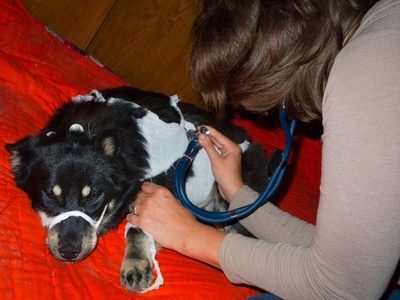While I was in school working on becoming a Veterinary Technician I jumped around to several jobs trying to figure out what was going to work best for me.
I started out my animal career working at Petsmart, jumped to being a receptionist in a day practice, then onto working as a vet assistant in a similar practice. Since I was in school, I was allowed to do a lot of the technician duties so I really got a feel for what I was in for.
One day while at school, I was just browsing the job board and noticed one for the local animal shelter. They were looking for technicians and assistants. At this time, I was getting pretty bored with just routine appointments and figured I’d give it a shot. I got the job and was in for quite the whirlwind.
First, I was accustomed to seeing 10-15 patients in a day with possibly 2-3 surgeries.
Since the shelter can get hundreds of animals in a day, this was dramatically different. I couldn’t believe the amount of animals that would pass through. On one of my first days we had a group of cats brought in that were living in less than desirable conditions. This home had 75 or more cats in it and I had to access every single one.
 In shelter medicine, a doctor isn’t always available nor on the premises so we’d be instructed to triage them and what we called “vet check” them.
In shelter medicine, a doctor isn’t always available nor on the premises so we’d be instructed to triage them and what we called “vet check” them.
A vet check includes aging, sexing, gross examination of any problems, heartworm test, and vaccines.
IF we found any issues a doctor would be notified and that animal would be put on the schedule for a veterinarian to look at. This was quite difficult to deal with sometimes when animals were in a lot of pain.
In those situations the doctors were “on call” and would usually come in or prescribe pain management so they animals didn’t have to suffer.
Surgery is quite different in a regular practice than it is in the shelter I got experience in. We would spay and/or neuter up to 20 cats and 10 dogs in a single day with just one doctor doing all of the work. We didn’t have a high budget so things like monitoring equipment didn’t exist.
You rely on your stethoscope and your judgment.
I believe that this alone made me a stronger technician. I have a lot of experience with anesthesia and recognizing planes of it without monitors. Don’t get me wrong, I love having monitors but I believe your ears are still one of your best tools.
Euthanasia is the most common topic I get asked about when people find out that I’ve worked in a shelter. It was pretty difficult to deal with at times but it is part of the job. I was fortunate enough to work for a shelter that had a very low euthanasia rate. We didn’t ever have to put anyone down for reasons like space. All of the deaths were justifiable for purposes like old age, illness, and injury.
I left my job at this shelter a few years ago. It wasn’t because I wanted too but because I moved across the country. It was by far one of the most rewarding positions that I’ve ever maintained. You get the chance to be the voice for and help out those animals that are either missing or in need of a forever home.
About the Author:
Erin is a 20 something mother, blogger, and Registered Veterinary Technician working in Emergency and Critical Care. There isn’t much free time to be had with a 14 month old son, 2 cats, 2 dogs, a rat, running a blog, and
working in the evenings. Hey, life is full of adventures right?
You can find more on her blog at http://www.unconventionalmommytails.com
